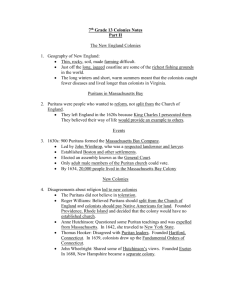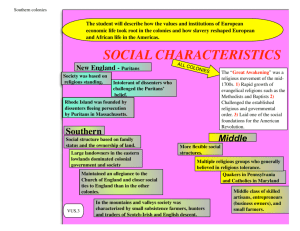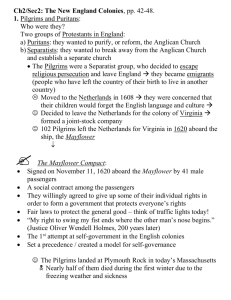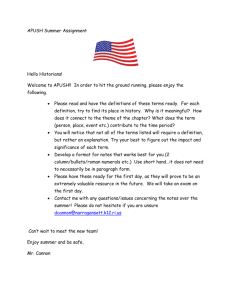PERIOD 2 1607
advertisement
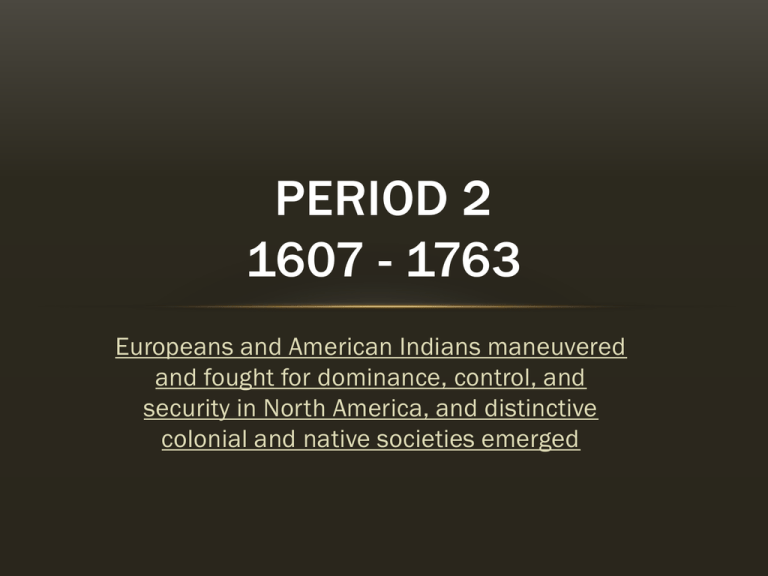
PERIOD 2 1607 - 1763 Europeans and American Indians maneuvered and fought for dominance, control, and security in North America, and distinctive colonial and native societies emerged KC 2.1 Differences in imperial goals, cultures, and the North American environments that different empires confronted led Europeans to develop diverse patterns to colonization • Spain • France The Netherlands • • Great Britain Explain the diverse patterns of European colonization in the New World by Spain, France, and England. Spanish French/Dutch British • Convert & Exploit • Gold, Silver • Trade alliances, intermarriage • Furs, products for export • Colonies based on AG • Large #s of people to populate settlements • Hostile towards NAs SPANISH COLONIES • Spanish arrive take over preexisting tribute/labor systems overthrow native rulers implementation of Spanish institutions (legal code, Catholic Church) • Encomiendas, mita system • Gold, silver • Society • 2/3 male • Racial mixture: mestizo (NA +SP), mulatto (AF + SP), Zambo (NA + AF) • sistema de castas • Control of empire to protect crown’s holdings • Spaniards out of cities large estates (haciendas) • NAs left in communities = authority of native rulers, speaking native language • Priests transform religion to fit NA culture CULT OF SAINTS: LATIN AMERICA • Illiterate use of iconography to tell stories, often replaced reading from Bible • Veneration of Saints from Old World transfers to New • Inspiration from Creoles, mulattos, etc. • Our Lady of Guadalupe • Woman appeared to poor Indian man outside of Mexico City (1531) • Place previously dedicated to Aztec goddess (was still worshipped there) • Image seen was brown-skinned Mary, shown as pre-Columbian womanspoke native language • Priest told he needed sign that it was Mary • Juan Diego- 3 miracles • Adopted as symbol of Mexican nationalism represents faith, hope, compassion. Embraces cause of the poor, ignored, voiceless, oppressed RELIGIOUS BACKGROUND- PROTESTANT CHALLENGE TO SPANISH EMPIRE • 1492- Euro = Catholic power • 1517- Luther & Protestant Reformation = end of unity through church, start of civil wars, social change desire to seize property from Catholic Church • Protestant groups • John Calvin (The Institutes of the Christian Religion, 1536) • Puritans, Huguenots • All damned by Adam’s original sin • Christ sacrifice redemption • BUT. . . Only for “elected” (predetermined to be saved) • Meaning? STRICT MORALITY, hard work • Values appeal to growing middle class • England- Cath v. Prot. • QE1- Anglican = Protestant • English Book of Common Prayer, marriage for clergy, leeway for doctrine • Calvinist groups want more separation from Catholic Church • Desire to “purify” church from influence of CC, religious revival = Puritans • Those who broke w/ CofE = Separatists THREAT TO SPANISH MONOPOLY ON NEW WORLD • Holdings hard to defend in Caribbean, rivalries revived, economy falls • Expensive wars, abundance of gold/silver, high tax on AG, high need of military service ( migration to America) • France • Jacques Cartier (1530s- St. Lawrence, NY, Canada) • Break until Samuel de Champlain after 1600 • Dutch • Provinces pass through inheritance to Spanish king • Were Protestant rebellion vs. Spain (1648 = Dutch republic) • Dutch “Sea Beggars” plunder Spanish ships, illegal trade w/ Sp. colonies, • English • QE1: “Sea Dogges” = John Hawkins, Francis Drake • Smuggling, piracy • Drake- raid Spanish towns, treasure ships (1570s) • 1588- Defeat of Spanish Armada = Protestant victory, God’s will for Protestantism, no fear of Spanish interference for American bound ships from England • Several exploration attempts, but. . . • QE1 death in 1603- NO British colonists in New World • Population increase during 16 th c. economic stimulation, expansion of commerce, manufacturing • Textile industry = beginning of capitalism, industrialism • Cottage industry (wood: estates merchants peasant workers weave into cloth merchants foreign markets • Mercantilism – goal to REDUCE IMPORTS, INCREASE EXPORTS • balance of trade, flow of gold/silver into England economic expansion • large merchant fleet, much wealth, trade w/ Turkey, India = foundation for colonization ENGLISH EXPLORATION • Sir Humphrey Gilbert & Sir Walter Raleigh • Royal patent to possess “heathen and barbarous landes countries and territories not actually possessed of any Christian prince or people.” • Settlers & descendents have rights/privileges of Englishmen “in suche like ample manner and fourme as if they were borne and personally residaunte within our sed Realme of England.” • Laws had to be “agreable to the forme of the lawes and pollicies of England.” • Gilbert- 1583, Newfoundland (Canada)- vanished during return home • Raleigh- 1587, OBX (NC)- 100 colonists under Gov. John White • White return to England for supplies • Return 1590- Roanoke abandoned, pillaged ENGLAND’S TOBACCO COLONIES: JAMESTOWN • Plantation colonies develop • Brazil, Jamestown, Maryland, Caribbean • Demand for sugar, tobacco + influx of colonists • 1606- K. James I land grant to VA Co. • All land from NC – southern NY = Virginia • 1607- all-male VA Co. group to America • No women, no farmers, no ministers • Who were they? • “unruly Sparks, packed off by their Friends to escape worse destinies at home.” • Survival based on extracting tribute from NA, search out commodities (pearls, gold) JAMESTOWN PROBLEMS • Goal? • “dig gold, refine gold, load gold” • Problem? • No gold • Settle in swampy area of peninsula- Jamestown (KJ1) • Little fresh water, refusal to plant crops DEATH (68%) • 1611- 1,200 colonists sent . . . Death persists (50%+) "he who works not, eats not.” –John Smith • Native American Interaction • Powhatan sees as potential allies • BUT tribute must go both ways • Corn for “hatchets . . . Bells, beads, and copper. . . And two great guns” • Viewed Jamestown as dependent community w/in chiefdom • 10 years of uneasy relations war • Who pays whom? • Tobacco • Native to Americas as medicine, stimulant • Rolfe cultivate crop for VA soil high $$ in GB, migration of settlers • GB demand increase for “vile Weed” (KJ1) • Taxes increase royal treasury • Powhatan view English as enemies- “not to trade but to invade my people and possess my country.” • 1618- VA Co. grant 100 acres to every resident • = Headright system • 50 acres of land/new immigrant passage paid THE VIRGINIA HOUSE OF BURGESSES • VA Co. create system of rep. gov. = VA House of Burgesses (1619) • Make laws, levy taxes • Gov. of VA and/or company council in GB had veto power • 1622 in VA- land-ownership, self-government, judicial system • All based on “lawes of the realme of England” • 4,500 more colonists • VA transition to SETTLER colony • VA Co. also recruit “Maides young and uncorrupt to make wifes to the Inhabitants” How did the proximity of the Powhatan Chiefdom affect developments in early Virginia? THE INDIAN WAR OF 1622 • Increase in colonists conflict w/ NAs • Led by Opechancanough- successor to Powhatan • 1607- attack on first “invaders” • Later, resistance to proposals from English for NA kids into English schools, conversion to Xnty • 1621 = Paramount Chief • “Before the end of two moons, there should not be an Englishman in all their Countries.” to Potomack NA group • 1622- surprise attack • 12 chiefdoms • 137 English settlers killed (1/3) • English seize fields, foods of the “naked, tanned, deformed Savages” • Enslave captured NAs , take control of land • “perpetual war without peace or truce” through 1632 • Result of fighting? • KJ1 revoke VA Co. charter • VA Royal colony = king, ministers appoint gov., advisory council (king’s Privy Council) • HofB remains, BUT legislation must be ratified by PC • Church of England into colony • Colonists pay taxes to support clergy • = model for royal colonies • Appointed gov., elected assembly, formal legal system, Anglican Church What factors impacted the political, social, and economic development of the colonial regions (New England, Middle, and Southern/Chesapeake colonies)? How did this create regional identities? MIDDLE/CHESAPEAKE COLONIES • NY, PA, NJ, RI/VA, MD • Diverse • Religion, ethnicity, demography • Export economy • Middle = cereal crops (wheat), animal husbandry (leather, dairy, candles, meat, butter, cheese) • Chesapeake = tobacco • Labor intensive • White indentured servants, African slaves MARYLAND • King James King Charles I • Secretly sympathetic to Catholics • 1632- land on Chesapeake granted to Lord Baltimore (Cecilius Calvert) • MD = refuge for Catholics • 1634- 20 gentlemen (Cath) + 200 craftsmen/artisans/laborers (Prots) est. St. Mary’s City (Potomac) • Conflict resolution = “no scandall nor offence to be given to any of the Protestants” and to “cause All Acts of Romane Catholicque Religion to be done as privately as may be.” • MD = high growth • Land to wealthy • Opportunity for artisans • Political conflict • Against LB, settlers elect representative body • Desire to initiate legislation • LB gives OK • Anti-Catholic agitation increased LB influence on assembly for Toleration Act (1649) • = all Xns have right to follow own beliefs, hold church services • Tobacco = $$ NEW ENGLAND COLONIES • MA, NH, RI, CT • Founded by Puritans • Desire community of like-minded believers • Close-knit, homogenous • AG + Commerce • Limited AG- poor soil • Local Ag for local consumption • Focus on commercial/market activity growing cities • Natural resources = commodities • Lumber (naval stores), fish/whale, furs, • Financial, entrepreneurial activity NEW ENGLAND • 1620- 102 Pilgrims arrive @ Plymouth Colony • 50% death rate • Strong work ethic, little danger from Wampanoags, religious toleration • 1630- Massachusetts Bay Colony chartered as joint-stock co. • Puritan exodus led by John Winthrop (1 st Gov. of MBC) • “We must consider that we shall be as a City upon a Hill…The eyes of all people are upon us.” • Boston • joint-stock representative political system (gov., council, assembly) • Rule by godly • Must be church member to vote, hold office • NO religious toleration! Puritanism = state=sponsored religion, Bible is legal guide • Who? • Family groups to form communities based on Protestant principles • Land distribution, balanced sex ratio, organized community society of independent farmers • MBC = “moral commonwealth” PURITANS 101 • Pilgrims = separatists • KJ1 threatened to drive “out of the land, or else do worse” America • William Bradford, Mayflower Compact, MBC • No royal charter to bind together • MC = alliance “together into a civill body politick” • Based on Puritan idea of self-governing religious congregations • Puritans = those wanting to “purify” COE of ceremony, hierarchy (Cath) • KC1 vs. idea of grace in salvation = “popery” to Prots • Purge of ministers who went against KC1 outflow of Puritans • In MBC- want reformed Xn society, “authority in magistrates, liberty in people, purity in the church.” – John Cotton • NE Puritans look for simplicity • Power lie w/ congregation • (Congregationalist churches) • John Calvin = inspiration • Idea of predestination • Only a few are saved • Life of anxiety- fear that person was not part of “elect” • Hope for conversion experience • Reliance on “preparation” & confidence in salvation (spiritual guidance from minsters) • Saved if obey laws DISSIDENTS IN MBC • Roger Williams • Target during purge of religious dissidents • RW = minister in Salem: religious toleration, separation of church & state, wrong to take NA land banishment in 1636 • Settled in Providence, others into Portsmouth, Newport • 1644- corporate charter granted by Parliament Rhode Island • Rule selves • Anne Hutchinson • Preach “covenant of grace” vs. “works,” too much emphasis on “good behavior,” God revealed directly to individuals (heretical) • Puritans- little gender equality. Women = inferior • “Thy desires shall bee subject ot they husband, and he shall rule over thee.” • 1637 banishment on basis of heretical views RI • Others: • 1630s- outward movement of “dissidents” • CT, New Haven, Saybrook combine into CT- 1665 • 1639- Hartford, Fundamental Orders of CT • = 1st constitution (rep. assembly, vote in Gov) • Legally established church, elected gov., assembly • Voting rights to property-owning men • Vs. church members like in MBC THE YEOMAN SOCIETY: 1630-1700 • NE Puritans from middle class England • No desire to be tenants of wealthy or be taxed by distant gov. • desire for close knit, self-governing communities • MBC & CT give land to groups of settlers, then distributed to male heads of family • Most own land, BUT no equality of wealth/status • “God had ordained different degrees and orders of men, some to be Masters and Commanders, others to be Subjects, and to be commanded.” – John Saffin, Boston merchant • Most land granted by proprietors to high social class • All receive some land • Most adult men have vote in TOWN MEETING (institution for local gov.) • Society in NE- independent households, self-governing communities • farmers having political power • Town meetings taxes, ordinances for fencing, road building, use of common fields, chose men to manage town affairs & reps for General Court (center of political authority in colony) • Chesapeake yeomen/Euro. Peasants have less power NEW ENGLAND CONFEDERATION • 1640s- fear of attacks from NA, Dutch, French military alliance • Help from England not likely • Civil war, distance • Confederation directed by board- 2 reps/colony • Limited powers on boundary disputes, return of runaway servants, dealings w/ NA tribes • 1684- end of NEC • Colonial rivalry, renewed control by King • Why important? • Example of ability to unify, take action toward common purpose PURITANISM AND WITCHCRAFT • Puritans see signs in natural world • Good & evil • Cotton Mather • Lightning = supernatural sign • Believe people tried to manipulate forces in nature (wizards, witches) • 1647 – 1662: 14 hung for witchcraft (older women) • Salem, 1692: • Girls w/ strange seizures accusations of witchcraft • Judge OKs use of “spectral” evidence • MBC tries 175 people- 19 executed • Why the mass hysteria? • Group rivalry • Accuser often young girls from poor farming families • Accused often older women who were wealthy, prominent church members • Puritan effort to subordinate women • 18/19 executed were women • Political Instability in MBC • And fears from NA attacks in Maine • Some accusers parents killed • = turning point for MBC, Puritans • Salem = high number of deaths • gov. officials limiting legal prosecutions for witchcraft • Beginning of Enlightenment thought (1675) • Rational, scientific view of world • Strange happenings have “natural causes” NEW YORK • KCII attempt to consolidate holdings along Atlantic • Close gap b/t NE & Chesapeake colonies • Issue? DUTCH • New Amsterdam on Manhattan Is./Hudson R. • 1664- land b/t CT and DE Bay granted to Duke of York (KCII brother James) • navy sent across Atlantic, takes control of colony from Gov. Peter Stuyvesant • Renamed New York • • • Orders to treat Dutch well, give freedom of worship, speak own language Also- new taxes, duties, rents. d • No representative assembly opposition of Puritans from NE in NY • 1683- James OKs NY Gov. to start rep. assembly NEW JERSEY • 1664- NY too large to administer James divide it • NJ area to Lord Berkely & Sir Carteret • 1674- split into W. NJ, E. NJ • Both give land offers to new settlers, religious freedom, representative assembly • Later, sold proprietary interest to groups of Quakers • Issues? Land titles change hands often bad property lines, confusion • 1702- combination of two Jerseys = New Jersey WILLIAM PENN & PENNSYLVANIA • 1681- KCII grant PA (incl. today’s DE) to Penn • = payment on debt to Penn’s father • WP a Quaker- simple Xnty (gender equality, nonviolence, resistance to military service) • Grew up wealthy, then join Religious Society of Friends • Religious authority in own self, not Bible or preacher persecution, jail • “The Holy Experiment” • PA = religious refuge • Frame of Gov. (1682-1683)- rep. assembly elected by landowners, written constitution, Charter of Liberties (1701- freedom of worship, unrestricted immigration) • WP govern from Philadelphia, PA, not England • Treated NA fairly, purchased land fairly from them • 1702- WP give lower 3 counties of PA own assembly = DE SOUTHERN COLONIES • SC, NC, GA • AG economy • Staple crops, long growing season, slave labor • Tobacco, rice, indigo, sugar (W. Indies) • High investment (land, slaves, equipment) high return • Carolinas- KCII give land to 8 nobles (= proprietors in 1663) • 1729- SC & NC formed from land grant by KCII • 1670- colonists from England, planters from Barbados Charlestown • Econ- fur/trade to West Indies (food) RICE ($$$) • NC- farmers from VA, New England • Small, self-sufficient tobacco farms • Few plantations (why? Few harbors, poor transportation) • Georgia = Last Colony • 1732- defensive buffer from Sp. FL & relief for overcrowded debtor jails • James Oglethorpe (Gov.)- Savannah (1733) • No rum, no slaves, but. . . Little prosperity • 1752- GB takes over, restrictions lifted, plantation system adopted COLONIAL BREAKDOWN • New England • Middle • Chesapeake/Southern • Restoration Colonies • Late 17th c. • Restoration of power to monarch, KCII, after Puritan rule (Oliver Cromwell) • Want to tighten control, gain back power from “big men” (Puritan magistrates, tobacco planters) who came to power during “lax” rule • Carolinas, Pennsylvania (DE), NY (NJ)
